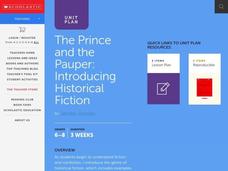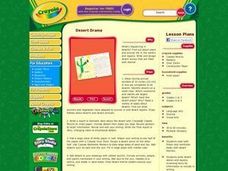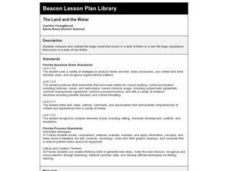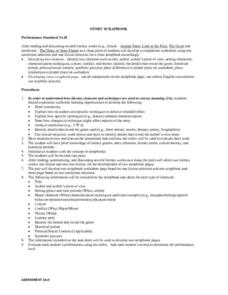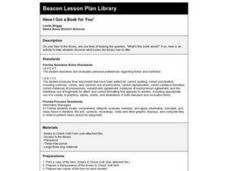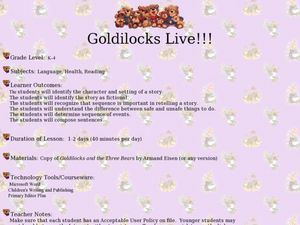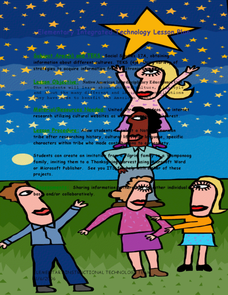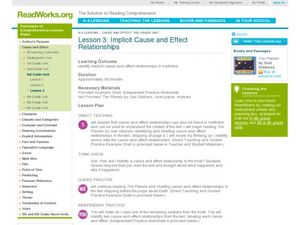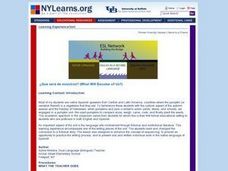Curated OER
The Seeds We Need
Learners apply word analysis skills to recognize new words, identify genres of fiction and nonfiction, and identify important themes and topics. They explore differences in plants, flowers, and vegetables. A book bag full of activities...
Curated OER
The Prince and the Pauper
Mark Twain, the famous American author, is often studied in the school system. Use "The Prince and the Pauper" to analyze the differences between the text and its video version. This lesson includes several culminating project...
Curated OER
Desert Drama
Students read both fiction and nonfiction books with desert themes. Then they write desert stories and reports, reviewing texts for information to include in writing. Students also design desert scenes with details and setting elements...
Curated OER
What Do You See at the Pond?
With What Do You See at the Pond?, young readers explore pond life and practice reading strategies. Learners first make predictions and then read the simple story independently. After a second read-through with a partner, kids come...
Curated OER
The Land and the Water
Third graders read "The Land and the Water," a fictional short story and an article about John F. Kennedy, Jr. and compare and contrast fictional tragedy to a non-fiction tragedy. They fill out a Venn diagram and write an essay using...
Curated OER
Recognizing Text Features of Fiction, Poetry, and Drama
Students start reading the book The Sign of the Beaver and create a book mark glossary to define vocabulary for the book. In this reading lesson plan, students also respond to the text by completing a journal entry.
Curated OER
Real and Fictional Wolves
Students demonstrate understanding of the difference between real and fictional wolves through critical reading and comparisons while using a Venn Diagram.
Curated OER
Is It Moose-Mooses or Moose-Meese?
Students play librarian and have to shelve books on moose after determining whether the books are fiction or non-fiction. They must study Alaska and follow a format of questions to determine where to shelve the books.
Curated OER
Start Book
Students review their notes, drawings, photos and writing from the field trip to share with the whole group. They make a fiction or nonfiction storybook as a group. They include writing from all students and can include artwork and...
Curated OER
Story Scrapbook
Students develop a comparison worksheet using one non fiction book and one fiction book they have read to be put into a class scrapbook. In their comparison students must have title, author, point of view, setting, characters, and other...
Curated OER
Historical Fiction - Based on facts or purely fiction?
Students, after reading an Accelerated Reader historical fiction book, research the actual historical time period portrayed in the book. Then, working in a cooperative learning group, they create a HyperStudio presentation.
Curated OER
Non-Fiction Read-aloud
Learners listen to the reading of a book about the area of science they are currently studying.
Curated OER
Have I Got a Book for You!
Fourth graders select a library book, read it and complete "Books to Check Out!" form. They compile their completed forms to a book to be displayed in the classroom for all readers to see.
DeKalb County Schools
Compare/Contrast
A series of reading activities is sure to engage your young readers! Based on comparing and contrasting ideas, the packet provides opportunities to compare characters, themes, texts, and other elements of fiction.
Curated OER
A House is a House for Me: Library Skills for Young Readers
Read Mary Ann Hoberman's book A House is a House for Me to introduce the idea that a library is a house for shelves of books. Young readers practice alphabetizing in the picture book (easy fiction) section of the library. They learn how...
Curated OER
How-To Books
Students apply their knowledge and create a how-to book of their own. In this early childhood language arts worksheet, students learn about non-fiction books and write their own procedural non-fiction booklets.
Curated OER
Immigration to the United States
Middle schoolers discover the implications of immigration. For this immigration lesson, students read fiction based on immigration experiences as well as non-fiction on the topic. Middle schoolers write and share book reviews of the...
Curated OER
Establish the Theme
Second graders explore the topic of nature. In this detective lesson, 2nd graders review non-fiction materials on nature and identify text, headings, diagrams, graphs, to establish the theme of the book.
Curated OER
Summarize This!
Students explore how to summarize a reading passage. They read non-fiction books. Students use a Venn Diagram to compare and contrast the two animals they read about. They write a summary using the information in their Venn Diagram.
Curated OER
Red Legs: A Drummer Boy of the Civil War
Students identify and interpret the life of a drummer boy during the Civil War as well as about a reenactment. Students listen to a fictionalized story or a Civil War reenactor and compare ot with the life of the drummer boy the story...
Curated OER
Goldilocks Live!!!
Study story elements with your young learners. Read Goldilocks and the Three Bears and discuss the order of events by making a story panel out of butcher paper. Sentences are given as suggestions for the panel, though you may...
Curated OER
Native Americans
First graders explore the lifestyles of several North American tribes. They investigate about the homes, food, transportation, and daily living habits of each tribe. Pupils use a map to locate several Native American tribes in North...
Curated OER
Implicit Cause and Effect Relationships
Cause and effect relationships can be found in both fiction and non-fiction texts. As they read the book, The Planets by Gail Gibbons, learners keep an eye out for cause and effect relationships. They chart all of the causes and effects...
Curated OER
?Que ser de nosotros? (What Will Become of Us?)
Students discuss uses of a pumpkin. They fill out graphic organizers. Students listen as the teacher reads a story, and participate by repeating sounds the objects make as the story progresses. One student narrates the story while others...

